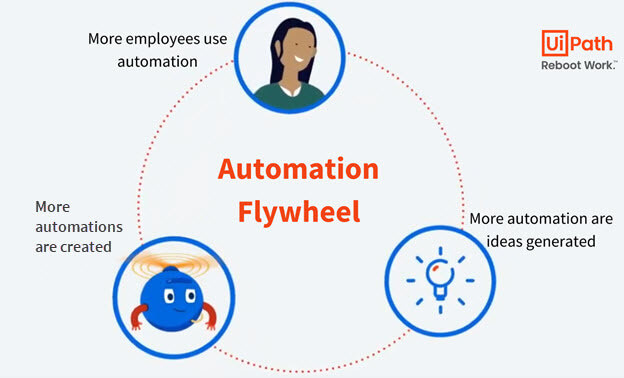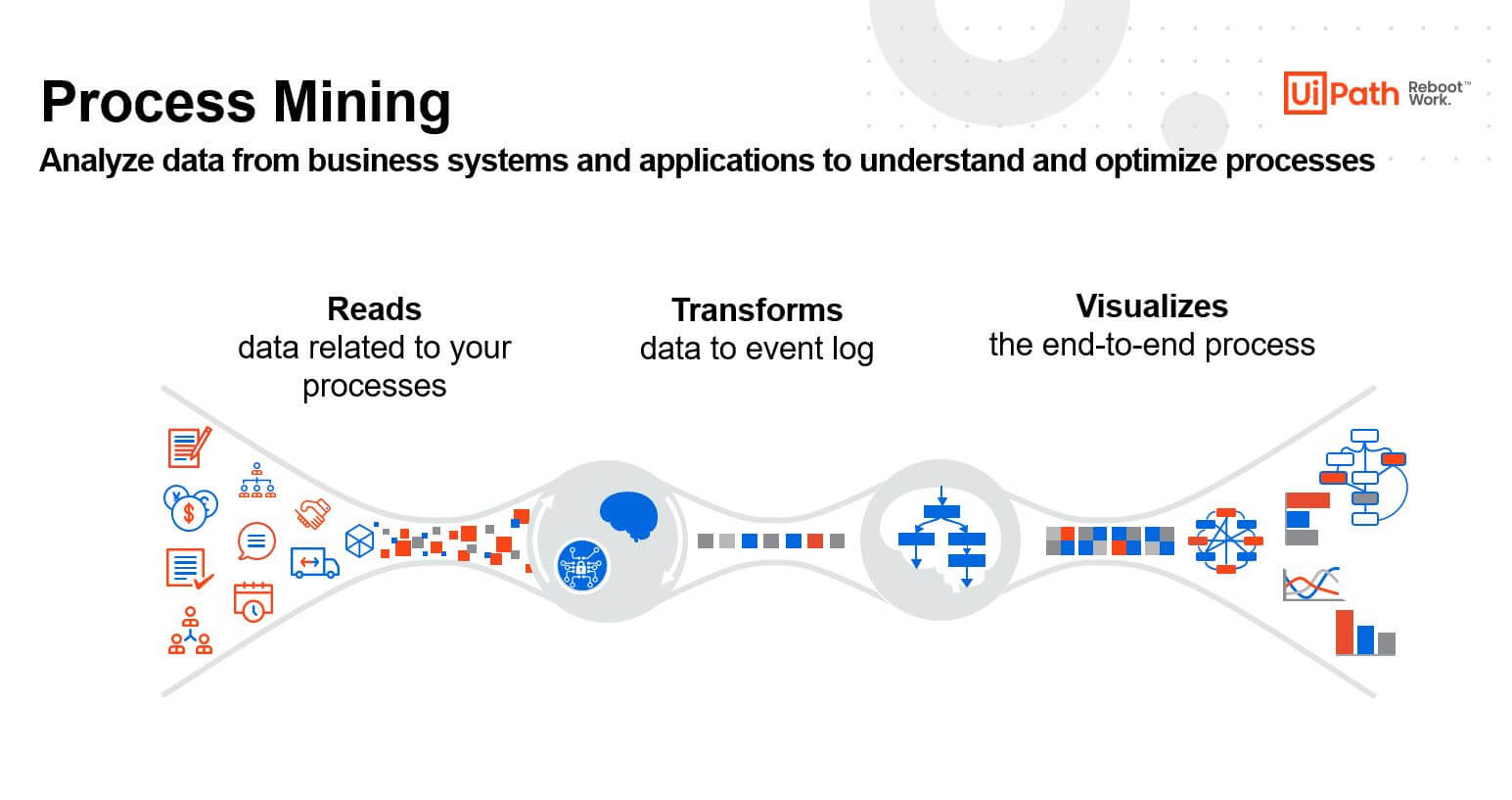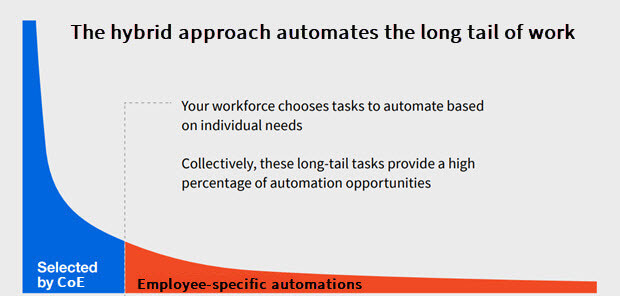A Simple Framework for Determining What Enterprise Processes You Should Automate
Share at:

In my last blog post, I shared insight into why now is the time to automate. But you may be left wondering what, exactly, you should automate.
Recent advancements in hyperautomation technologies have busted open the door to what’s possible for companies to automate. When you combine that with the fact that the use cases for these technologies are as unique as the companies that leverage them, it is understandable that many do not know where to start. While there is no one-size-fits all answer, we are seeing an emerging framework that successful companies are leveraging to determine what processes to automate.
UiPath is here to help. In this article, I will walk you through that framework. The fundamental elements are:
Finding and prioritizing high-value automation opportunities via centralized governance
Democratizing the generation of automation ideas by encouraging the workforce to suggest and build automations themselves
Creating a hybrid model that combines these top-down and bottom-up approaches
A hybrid approach that combines both centralization and democratization of automation development unlocks an “automation flywheel.”
The automation Center of Excellence (CoE) builds and distributes automations, which employees use. Once employees get used to working with automation, they start to have ideas for more software robots. If they are technically savvy, human workers can start building those automations themselves. Or they can simply suggest them to the CoE, which will evaluate and prioritize new process automation opportunities. This is the flywheel effect, and once it gets moving it sustains itself.

When that automation flywheel is in motion, uncovering what to automate becomes a positive side effect. If your framework is good, you will never have to worry about what to automate again. The use cases become clear. Artificial intelligence (AI) suggests what to automate based on data, while your people tell you what work needs to be automated based on lived experience.
Now, let’s dive into each of the three components of the framework.
Find and prioritize high-value centralized automation opportunities from the top down
By empowering your CoE to create and carry out a top-down automation strategy, you allow this central governance body to figure out which processes will drive the biggest value for the company when automated.
Your CoE should include champions from each department and team—who each have their own soft and hard incentives—to advocate for the needs of each business interest within your company.
Empower your CoE with scientific discovery tools—such as UiPath Process Mining—to find automation opportunities across the enterprise. This tool, guided by your overall automation strategy, will uncover opportunities that you might otherwise miss.

Recommended reading: Process Mining Value: What it Means for Your Business
Additionally, your lines of business and finance will certainly be able to point to processes that have significant scale and/or cause the most pain for people in their day-to-day work. These automation opportunities should enter the decision set as well.
Your CoE can prioritize projects based on their potential return on investment (ROI) and efficiency savings with UiPath Automation Hub. Using this cutting-edge tool, they can manage your entire automation lifecycle with data-driven process prioritization, ROI visualization, and a central production command center.
After automations are built and rolled out, your CoE can monitor robot usage and performance with a central licensing model through UiPath Insights to track, measure, and model performance across your entire automation program.
Top-down automation strategy and management and a suite of powerful discovery tools like the ones in the UiPath 2020 FTS release are a groundbreaking combination. Together, they support the process automation needs of your company and employees to ensure the smooth adoption of automation today and success tomorrow.
Democratize the generation of automation ideas from your workforce
You want your employees to be digital and be part of the change.
Singtel, UiPath Live: The Release Show
As powerful as a top-down strategy is, it can only get you so far without involving your people. Each person does their work in a unique manner. This means that the opportunities for automation can be as specific as the needs of each employee in your organization.
On a single-employee level it may not seem like a big deal, but when you add up the productivity lost, it is staggering.
Imagine if every employee at your company finds a way to use automation to save an hour of work per day. You’ll achieve greater ROI than would have ever been possible with a top-down approach alone.
This isn’t a far-flung reality. It’s achievable—as Singtel’s automation journey demonstrates—but only if you get every employee on board and give them the tools to build and submit their own automation ideas. Every person should have their own robot assistant that can load automations provided by the CoE.
In addition, you need to give technically savvy citizen developers the tools, such as UiPath StudioX, that enable them to build their own automations. The results can be transformative. For example, after Singtel partnered with UiPath to run a bot-a-thon, their employee automation adoption skyrocketed. In fact, a Singtel employee was able to create a robot named Valbot that turned a 285-click, 4.5-hour process into a one-click, 12-minute workflow (that’s 4.3 hours saved every time the process ran). All thanks to employee empowerment with the right automation tools.

When you empower employees to submit and build their own automation ideas, you make it easier than ever for people to drive their own productivity gains. As a result, you set the stage for ‘a robot for every person,’ which is key to achieving automation at scale.
The best part? Your employees want this to happen.
According to one of our recent surveys, 68% of workers believe automation can improve their productivity and save time in their day-to-day work. And they’re right.
“This whole initiative is not an investment in robots; it’s an investment in people,” said Lum.
The ability to put automation power in the hands of employees and enable them to create their own automations with UiPath StudioX helped Dentsu leverage the most valuable skill sets of their workforce.
These stories from our customers showcase better than anything else that when you empower your people with automation tools within a hybrid governance framework, you lay the groundwork for innovation at scale like never before.
Want more inspiration from organizations around the world empowering employees with automation? Check out our library of UiPath customer stories (you can filter by industry, geography, and more).
Combining both into a hybrid approach of what to automate
When you implement both a top-down and bottom-up approach to determining what to automate you’ll create a feedback loop that amplifies the use cases and benefits of automation and drives adoption forward quickly. So, we strongly recommend you pursue both paths in order to make which processes to automate surface organically in your organization.
In addition, combining both top-down and bottom-up approaches increases the scope of automation reaching the long tail of work.

Think back to the automation flywheel I talked about in the beginning of this post: in the same way that top-down prioritization of automation opportunities creates more and more automation ideas as time goes on, bottom-up employee ideation uncovers unseen opportunities. As the flywheel starts spinning from the top down, it picks up new ideas and opportunities from the bottom up.
And when that automation flywheel starts spinning you no longer need to wonder about what to automate. The process automation ideas and opportunities will be organically provided to you from all directions, whether it’s through AI, business leaders, or your employees themselves.
Determining what processes to automate becomes less a question of finding opportunities, but about prioritizing and selecting the best ideas.
It’s time: Find out what to automate
Hyperautomation is here to make a robot for every person a reality and permanently disrupt business and personal productivity. You just need to decide where to start.
I had the pleasure of co-hosting our recent UiPath Live: It's Time to Automate show. During the live show, we discussed why industry leaders and analysts know it’s time to automate now. If you missed it, you can still watch the recording of the full show.

Chief Marketing Officer (CMO), Ada
Get articles from automation experts in your inbox
SubscribeGet articles from automation experts in your inbox
Sign up today and we'll email you the newest articles every week.
Thank you for subscribing!
Thank you for subscribing! Each week, we'll send the best automation blog posts straight to your inbox.



